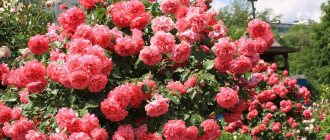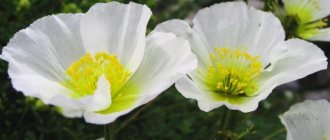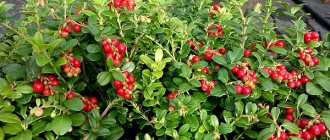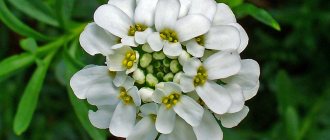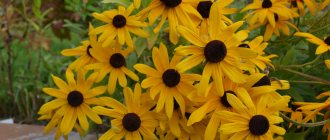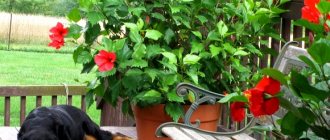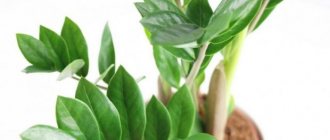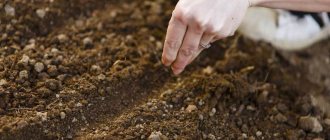Kolkwitzia charming, named after professor botanist Richard Kolkwitz, is a deciduous shrub and a beautiful flowering tree. Botanists attribute this magnificence to the honeysuckle family, and gardeners dream of planting this Chinese miracle in their garden. The central region of China is the natural habitat of this plant. Landscape designers in many countries with temperate climates actively use the decorative properties of this crop to decorate the garden.
Description of the collection
In its natural habitat, kolkvitsia grows to a height of three meters, and in the European part of Russia no more than 2 meters, and is a type of shrub. The branches grow in large increments with densely drooping hairs. The bark of old trunks has a red-brown color and peels off like honeysuckle. Bright green oval-shaped leaves (oppositely paired, 3.5-8 cm long) turn yellow in autumn.
It blooms profusely, covering the entire bush in the shape of a ball, with pinkish, bell-shaped inflorescences with five petals. The buds look very attractive and attract attention. Because of such luxurious blooming of flowers, it is impossible to even see the foliage, and such a philharmonic continues throughout the spring and covers part of the summer.
Varieties of kolkvitsia
In the Russian zone, only two species are known:
- Rosea;
- Pink cloud.
Rosea is the most popular variety among gardeners in the country. At the moment of blooming, the flower stalks have a bright pink hue, but as they bloom, the inflorescences become white. They look spectacular in compositions with bushes of rich emerald green leaves. In autumn, the foliage turns a bright orange color. The throat of the flower has an orange-yellow stripe. The shrub requires careful care and crown formation.
Pink cloud (Pink-Ckoyd), literally translated, sounds like pink clouds; when grown in southern regions with warm climates, in temperate zones they grow up to 1.5 meters, both in height and in diameter. One of the most common varieties in Russia is Pink Clouds. The bush is resistant to both drought and frost. The shoots branch well and form easily.
There are no significant differences between the plants in terms of the characteristics belonging to each variety. They mainly differ in the saturation of the color scheme and the size of the petals. Throughout the first half of June, when all other ornamental shrubs have already stopped blooming, this plant continues to smell sweet and bloom.
Types and varieties with photos
The deciduous shrub is native to the mountains of Central China. The height of the bush in natural conditions is 2 m, slightly inclined branches are covered with pointed, dark green leaves.
The greatest decorative value are bell-shaped flowers collected in inflorescences. They cover the bush abundantly so that the foliage itself is not visible.
The flowering period is long, it is 20 days. In autumn, the bush becomes elegant due to the fact that the foliage changes color.
The plant was discovered only in the 19th century. It was named after the German botanist, Richard Kollkwitz. The shrub was classified as a member of the Honeysuckle family.
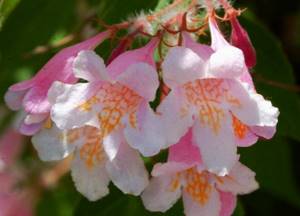
There is only one species - lovely kolkvitsia. The name itself speaks of high decorative properties. In the conditions of the Moscow region and the entire central zone, kolkvitia grows up to 1 m. Young shoots are pubescent with hairs, old ones are covered with red bark.
Another name for the plant is Pleasant Colquitia. It is not surprising, because during the flowering period the branches seem to turn into a lacy cloud.
At first, the flower stalks have a rich pink tint, and towards the end of flowering they acquire white tones. The shrub is an excellent honey plant.
Kolkwitzia amabilis has been grown in Russian botanical gardens for half a century. All specimens show an average rate of shoot growth.
It was noted that the bushes bloom in the fifth year of life, their fruits ripen in September. In cold winters, some of the branches freeze, but the bush itself quickly recovers next spring.
Collection selection began several decades ago. Today there are only a few varieties.
Suitable for the middle band:
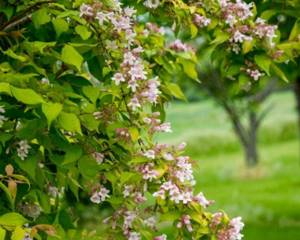
"Maradko". A dwarf plant with a weeping crown shape. The photo of the collection shows that the flowers cover the bush as if with snow. Flowering continues from mid-May to mid-June. In autumn the leaves turn yellow and red. The variety is frost-resistant.
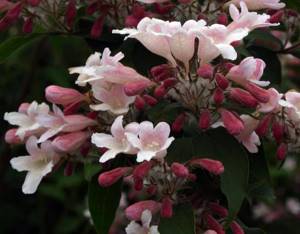
"Pink Cloud". Kolkvitsia does not exceed 120 cm in height. The shoots branch well, the flowers are much larger than those of other varieties. The bush is resistant to drought and frost, excellent for urban landscaping.
In garden plots, kolkvitsia decorate the banks of artificial reservoirs, alleys, lawns and areas along fences.
Planting colquitia in open ground
When choosing a place to plant in the ground, it is important to take into account that the plant is light-loving, although if there is a slight shadow, it will tolerate it well. Fertile soil with moderate moisture is what the kolkvitsia needs for growth and development. The area where the bush will grow must be protected from cold winds. Despite the fact that the plant can withstand frost down to -30 °C, after very cold winters, young shoots are partially damaged.
Planting in open ground is carried out in the spring in well-warmed soil, when the threat of return frosts has passed. If the site sits in water for a long time in the spring, then it is absolutely not suitable for this plant.
It is better to prepare the planting hole in advance about 14 days before planting in open ground, the soil in it will compact and settle. The hole should be at least 40 cm deep and 50 to 60 cm wide. Prepare the soil mixture as follows: sand, turf, humus, in the proportion (1: 2: 2). Fill the hole with a thoroughly mixed mixture and after 14 days add 80-130 g of complex fertilizer or half a bucket of ash to the soil and plant the seedling.
According to the age of the bush, it is advisable to be 1-year-old or 2-year-old for successful survival. Water thoroughly immediately after planting and cover with mulch, preferably coconut shavings.
The bush can bloom for the first time already in the second year after planting in open ground.

Landing
For planting in open ground, you should choose an open sunny area, but without strong sun. Can also grow in partial shade. However, in a dark place the branches of the plant begin to stretch strongly.
The soil must be moist and fertile. In this case, high-quality drainage is very important. In winter, there should be no stagnation of water in the soil. The ideal option for planting shrubs is light sandy loam soil.
The best time to plant kolkvitsia is spring. The soil must be warmed up. It is recommended to fill the planting hole with a composition of the following components:
- Fertile land;
- Sand;
- Humus.
It is recommended to take all components in a ratio of 2:1:2.
The depth and diameter of the pit should be about 1.5 meters. If you are planning a group planting, then it is recommended to leave a distance of about 1.5 meters next to the seedling, otherwise the planting will not look so beautiful.
In autumn, cuttings can be planted in open ground, but if the climate is cold, then in winter the cuttings may freeze and die. Thus, in temperate latitudes the plant is planted extremely rarely before winter.
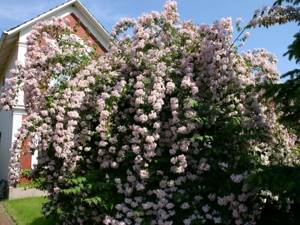
This is how monumental and powerful the kolkvitsia looks in conditions of a favorable climate for it (Europe)
Caring for colquitia in the garden
Successful growth and flowering depend on proper care. It is always important to maintain soil moisture around the tree trunk, and water only with warm water.
For good growth and development, the plant must be fed. These can be infusions of fresh manure in a ratio of 1:10, and at the beginning of summer they add double superphosphate 30-50 g per 10 liters of water per bush.
When flowering ends, they stop fertilizing the flowering plant so that new shoots do not grow, since they will not have time to ripen. At this time, formative pruning is performed. It is necessary to trim the bush after the final ripening of the fruits, and all young shoots are removed.
In early spring, a sanitary pruning is done, cutting off all branches and stems damaged by frost and pests. If there is a need to transplant the bush to a new place, then the survival rate will be high at this time. In the fall, when preparing the bush for winter, it is mulched well again and covered with pine spruce branches to prevent rodents.
Reproduction
Like most other perennial crops, kolkvitsia can be propagated in a variety of ways: by seeds, layering, as well as by cuttings and dividing the bush. Let's take a closer look at each of them.
Seeds
Let us immediately note that the seeds of this plant have a rather low germination rate - no more than 25-30%, and this must be taken into account when choosing this propagation method.
When breeding colquitia from seeds, special attention should be paid to the fertility and nutritional value of the soil. It is advisable to make it from a mixture of peat and river sand, taken in equal quantities
Cultivation of seed material begins in early April. The seeds are first stratified - kept for 2-3 months in a cool place at a temperature of 0 to +5 degrees Celsius. The seeds should be stored in a hermetically sealed bag with the addition of moistened vermiculite.
Before planting, it is advisable to soak the seeds in a sulfuric acid solution for 10 minutes. The prepared seeds are deepened into the soil mixture by 5 mm, after which they are watered abundantly. The next year after planting in the spring, the seedlings are picked up and moved to a permanent place of growth.
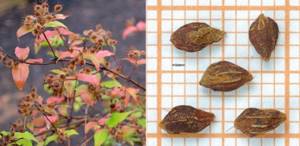
By layering
This method is considered one of the most effective
To propagate colquitia, you need to select a healthy shoot, dig a small groove under it, then bend the branch, carefully place it in the groove and pin it to the ground. In the area where the layer comes into contact with the ground, it must be slightly cut and treated with any growth stimulant, for example, “Epin”
The shoot is sprinkled with earth so that the top remains open.
The cuttings are kept in the ground for about a year, keeping it moist. Next spring it will have taken root, then it can be separated from the parent bush and moved to a permanent site.

Cuttings
Propagation of kolkvitia by cuttings is permissible only in regions with warm winters, since this vegetative material is characterized by reduced resistance to frost.
Cuttings are carried out using one of two methods.
- Lignified cuttings. In this case, in November, the woody shoot is removed from the bush and carefully buried in a slightly shaded place. Before the arrival of cold weather, the cuttings are mulched with rotted leaves, compost or hay and sprinkled generously with snow. Next year the young plant will take root and it will be possible to transplant it to a permanent site.
- Annual cuttings. This work is carried out in early spring: young one-year-old cuttings are separated from the parent bush and cut into pieces. After this, they are placed in containers with soil mixture, covered with a greenhouse and kept in a warm, bright place. With the onset of the summer season, you should take the planting material outside, place it in the shade and moisten it daily, preventing the earthen ball from drying out.
As soon as young shoots appear, the plant can be transplanted into open ground. In the fall, the seedlings are covered with agrofibre or other material; with the arrival of warmer weather, the seedlings can be moved to a permanent place.
Root division
Another popular method of propagating shrubs, which is used when replanting. The bush is carefully dug up, the roots are carefully examined, and all dry and rotten areas are cut off. Then they are divided so that a healthy shoot remains in each part, the cut areas are treated with charcoal and planted.
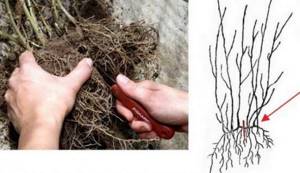
Reproduction of Colquitia
The plant is propagated as follows:
- Generative method (seeds);
- Vegetative method (layering, cuttings, dividing the bush).
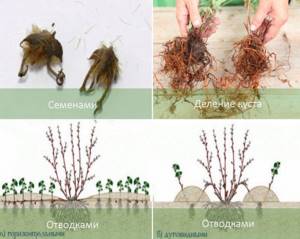
Generative method
The process is long-term and not always successful. The germination of the seeds is poor; this is hampered by a hard shell with hard protrusions. In order to destroy it, thoroughly rub it with sand or keep it in concentrated sulfuric acid for several minutes. To increase germination, they must be stratified in the refrigerator on the shelf where vegetables are stored for 3 months. After this time, in April, they are sown somewhere in long containers with a good substrate: peat, sand, turf, humus. The seeds are not very large and it is not recommended to plant them deep into the soil. A temperature of +20...22 °C is just right for germination. A pot of kolkvitsia is watered abundantly, covered with film, and kept warm. In indoor conditions it will grow until next spring.
Reproduction by layering
The most effective and reliable way. Having selected the desired shoot, it is bent into a dug groove, a small incision is made, treated with Kornevin to stimulate root growth and sprinkled. After rooting, they are transplanted into prepared holes next spring.
Cuttings
They propagate both in spring and autumn. True, the autumn one turns out to be of better quality. Selected cuttings are cut and wrapped in film, and then put away in the basement until spring, or coated with Kornevin and planted in a greenhouse or in pots for indoor germination. After 2 years they can be planted in open ground. Cuttings wrapped in a plastic bag can also be stored in the refrigerator on a vegetable shelf until germination.
Dividing the bush
You can use this method of propagation, such as dividing a bush, if you transplant the entire seedling. The bush is removed from the ground and inspected, removing rotten roots, then divided into parts, taking into account that each gets a powerful root and a developed stem. The cut areas must be covered with coal to avoid the entry of microbes and rotting of the roots. The bushes prepared in this way are planted in trenches or holes.
The first years after planting the plants, while they are still young and their branches are not mature enough, the bark is susceptible to the destructive effects of frost; they must be covered before winter with spunbond or lutrasil.
Reproduction methods
Colquitia can be propagated by seeds, layering and cuttings.
Seeds
The seeds of the plant are planted in open ground before winter, but they can also be planted in a greenhouse in the spring to produce seedlings.
For spring planting, the seeds need to be artificially wintered for 2 months. A regular refrigerator is suitable for this purpose. At the end of March, the seeds of the kolkvitia are placed in the freezer for two weeks, and then transferred to the refrigerator shelf for the remaining period.
The seeds prepared in this way are sown in containers with soil, covering them to a depth of one centimeter. Then, until the spring of next year, they are grown in a greenhouse, after which they are planted in the ground.
Layerings
To propagate colquitia by layering, the following method is used. Holes are made near the bush. Then last year's shoots are carefully tilted towards them. Those parts of the shoots that will be placed in the holes are freed from foliage at intervals of 10 to 15 cm. Then the finished layering is secured in the holes with wire loops and dropped in drops. Loops allow you to securely secure future seedlings, which, in turn, contributes to better rooting.
The planting sites do not require watering. For successful growth, they only need precipitation and juices obtained from the mother bush.
The appearance of sprouts means that the cuttings begin to develop a root. During this period, the young bush can be fed with nitrogen fertilizers.
Layers need shelter for wintering. To do this, you can dig the plant well and also cover it with leaves or straw. With the onset of spring, the shelter is removed, and the young columbine is carefully separated from the mother bush and transplanted to a permanent place.
Cuttings
Propagation of kolkvitia by green young cuttings is only suitable for regions with mild winters, since rooted cuttings have low frost resistance and therefore can freeze at too low temperatures.
This type of reproduction is carried out in mid-summer. Young shoots of the plant are cut off and soaked for 12 hours in a “Kornevin” solution made according to the instructions for the drug. After such preparation, the cuttings are planted in a greenhouse or other warm and humidified room, where they grow until next spring. Typically, only half of the cuttings planted in a greenhouse become suitable for planting in open ground.
Propagation of the bush by cuttings with woody trunks is carried out in late autumn. Suitable branches are cut and buried in open ground in a shady area of the garden. In winter, the plants are buried in drops and also covered with a thick layer of hay, straw or leaves. In spring, the shelter is removed. And the cuttings themselves, feeling the warmth, will begin to produce young shoots and roots. It is better to move them to a permanent place after a year.
Diseases and pests
Colquitia is quite resistant to the invasion of various pests. But in hot weather it can be attacked.
The honeysuckle aphid can cause great damage to plants; young leaves and shoots dry out and fall off. If such pests are detected, they are immediately destroyed with drugs such as: Aktara, Aktelik, Fufanon. Spraying should be carried out twice, three times with an interval of 7 days. Since the first treatment kills adult insects, but the eggs remain undamaged, the subsequent treatment will destroy them too.
But not only aphids, but also the fingerwing caterpillar, which gnaws the berries, as well as the leaf beetle can harm the decorative appearance of the plant.
If the number of pests is small, they are collected by hand, and if the damage is severe, they can be sprayed with Biotkin, Herold or any other effective preparation. The greatest damage can be caused by the scale insect, which can destroy the bush completely.
Viruses and fungi can cause irreparable harm to colicweed; if it is a bacterial disease, then such a plant cannot be treated. It is dug up and burned.
If these are just microscopic fungi that damage the foliage, and are visible in the form of various spots, and they fall off the branches, then this disease is treated - chlorosis. The drugs Fosporin and copper sulfate will successfully cope with this problem.
Mister summer resident informs; Features of planting columbine in the Moscow region
Kolkvitsi seedlings also grow in the temperate climate of the Moscow region. Of course, soil plays an important role in the formation of a bush. Loose, nutritious soil is the key to the success of the rapid growth of colquitia and the formation of peduncles. During the dry period, the soil is moistened, and to retain moisture, a thick layer of mulch is laid, it is good if it is peat and compost, and pine bark on top.
After watering, the bark wood will be saturated with moisture, and if a dry period occurs, it will not allow the roots to dry out. In the Moscow region, it is imperative to protect the bush from severe frosts, so that during cold, snowless winters the plant is covered as much as possible, directly affecting the young seedlings. It is necessary to cover not only the crown, but also the root system, this is especially important in snowless winters.
The lovely Colquitia is pleasant in its beauty of an airy pink cloud. With proper care, after 6-7 years, a beautiful and lush tree will form, with spreading branches in the shape of a ball.
Having planted this beautiful bush in a country house, at the dacha you can count on its gorgeous flowering and summer aroma with brightly colored autumn foliage.
Colquittia transplant
An overgrown shrub can be replanted every five to six years to a new location. This is best done in the spring, when the air temperature stabilizes. This way the plant will take root well and produce young shoots. The lovely Colquitia tolerates transplantation to a new place well. It takes root quickly and blooms well. At this time, you can propagate the bush by division. Algorithm for transplanting an adult plant or seedling with a closed root system:
- The shrub is carefully dug up or removed from the container, being careful not to damage its roots.
- Prepare a planting hole with a size exceeding the dimensions of the root system with a lump of earth.
- Pour a soil mixture enriched with nutrients into the hole.
- The bush is placed in a planting nest, its roots are covered with earth, avoiding deepening the root collar. The soil is compacted.
- Transplanted kolkvitsia requires abundant watering and mulching of the tree trunk circle.
